Sociology of Me: A Comparative Analysis of Life in India and Canada
VerifiedAdded on 2023/01/13
|8
|3025
|98
Essay
AI Summary
This essay, titled "Sociology of Me," presents an autobiographical analysis of the author's life, framed within a sociological perspective. The author, having lived in both India and Canada, explores the impact of cultural differences on various aspects of life, including marriage, education, work culture, and employment opportunities. The essay incorporates an interview with the author's mother to provide comparative insights into social norms, values, and traditions in the two countries. Key themes discussed include marital practices, educational inequalities, diverse lifestyles, work ethics, and economic conditions. The author highlights the contrasting approaches to women's roles, career prospects, and overall quality of life in India and Canada, concluding that Canada offers a more modern and equitable environment despite the challenges faced in adapting to a new work climate. The essay emphasizes the influence of technological advancements and environmental factors on migration and the resulting cultural shifts.
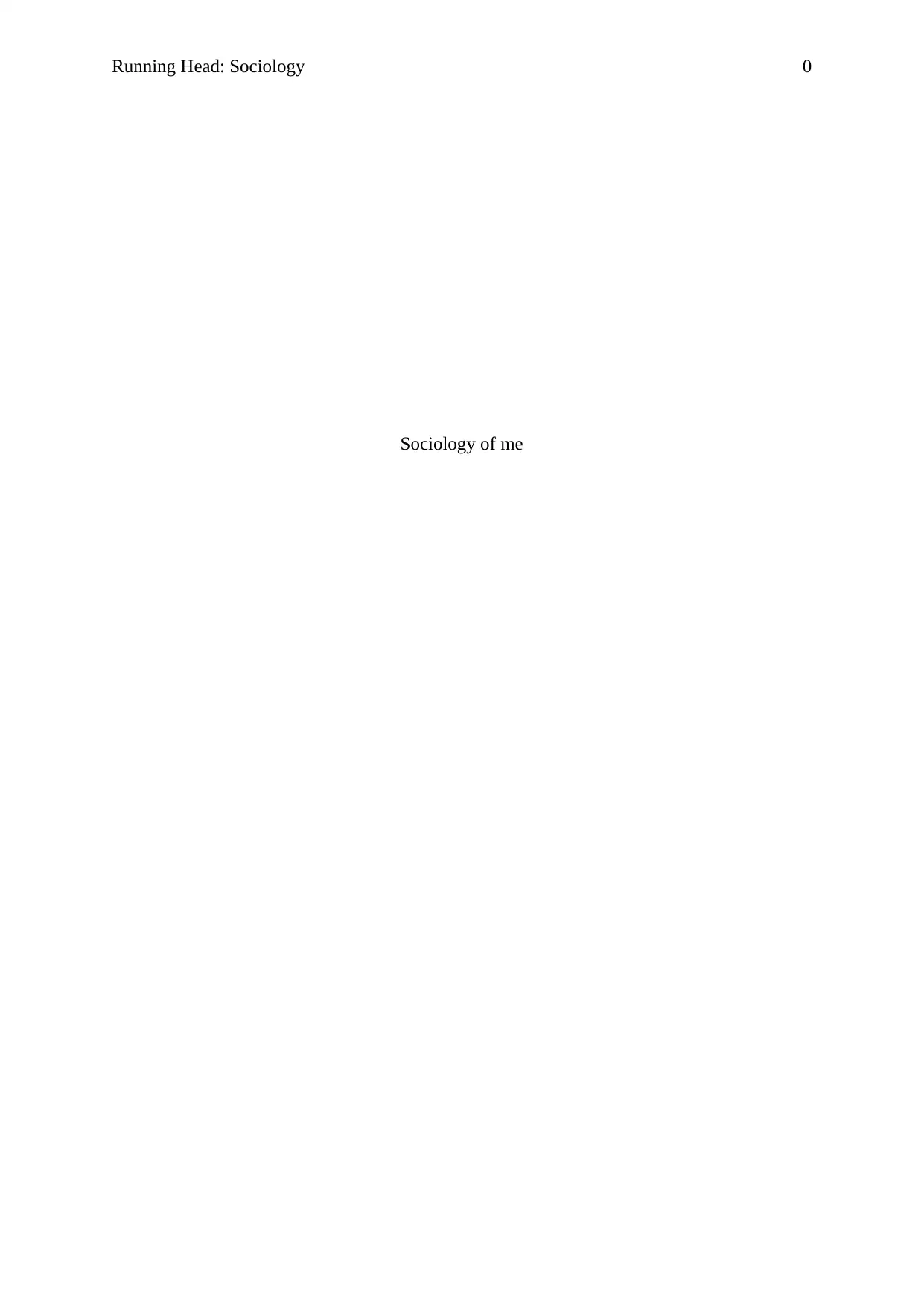
Running Head: Sociology 0
Sociology of me
Sociology of me
Paraphrase This Document
Need a fresh take? Get an instant paraphrase of this document with our AI Paraphraser

Sociology 1
Sociology of me
The sociological imagination, which has been developed during my crucial period of
life, gives the responsibility to deal with our own lives and make choices. It permitted to
make more aware of looking at my life from a sociological perspective. I was earlier living in
India and later shift to Canada to lead a better and happy life. I believed that after residing in
India and Canada, one is able to figure out the difference between both the nations in terms of
different social norms, cultures, religious values, education system, and career opportunities
(Storr, MacLachlan, Krishna, Ponnusamy, Drynan, Moliner & Bossers, 2018).
I am taking ahead of the essay to marital pressure, which presents a combination of
richness and foreign influences generating a unique experience. India is known for its values
and hospitality and more importantly charm of culture, which involves dresses, music, dance,
literature, etc. When I was in India, I have observed that Indian people are very rigid in
following marriage rituals and values. It is stated that holy matrimony is the biggest cultural
difference among these nations. As per the Hindu Marriage Act, 1955, the minimum age limit
for marriage of girls is 18 years and for the boys is 21 years. In Indian culture, marriage is
seen as the alliance among two families, responsibilities, and duties. The preference is given
to arrange marriage irrespective to love marriage, as an individual choice is not given much
importance. After living in Canada, I have noticed that in Canadian culture, marriage takes
place by the consent of both the people, as they are more inclined towards love marriage.
According to the Civil marriage act, any person who is under the age of 18 years is not
entitled to marriage (Gurung & Prater, 2017).
After discussing the scenario of marriage in both countries, now the essay will
conduct an analysis of education. In India, women are more suppressed and treated with
inequality in respect of work, education, and inheritance. They have not given equal
opportunity to continue their education and achieve the goals and ambitions in their life. An
Indian person grows with a mindset that girls should not get educated or work, as they should
take care of the households work. I have seen in Canada that women’s are treated with justice
and equality, and satisfy their ambitions and dreams of their lives. Canadian thinks that
women also have an equal right to getting education and inheritance, which is distributed
equally. In the organization, women are also paid equal wages along with the men (Shepherd
& Lewis-Fernandez, 2016).
Sociology of me
The sociological imagination, which has been developed during my crucial period of
life, gives the responsibility to deal with our own lives and make choices. It permitted to
make more aware of looking at my life from a sociological perspective. I was earlier living in
India and later shift to Canada to lead a better and happy life. I believed that after residing in
India and Canada, one is able to figure out the difference between both the nations in terms of
different social norms, cultures, religious values, education system, and career opportunities
(Storr, MacLachlan, Krishna, Ponnusamy, Drynan, Moliner & Bossers, 2018).
I am taking ahead of the essay to marital pressure, which presents a combination of
richness and foreign influences generating a unique experience. India is known for its values
and hospitality and more importantly charm of culture, which involves dresses, music, dance,
literature, etc. When I was in India, I have observed that Indian people are very rigid in
following marriage rituals and values. It is stated that holy matrimony is the biggest cultural
difference among these nations. As per the Hindu Marriage Act, 1955, the minimum age limit
for marriage of girls is 18 years and for the boys is 21 years. In Indian culture, marriage is
seen as the alliance among two families, responsibilities, and duties. The preference is given
to arrange marriage irrespective to love marriage, as an individual choice is not given much
importance. After living in Canada, I have noticed that in Canadian culture, marriage takes
place by the consent of both the people, as they are more inclined towards love marriage.
According to the Civil marriage act, any person who is under the age of 18 years is not
entitled to marriage (Gurung & Prater, 2017).
After discussing the scenario of marriage in both countries, now the essay will
conduct an analysis of education. In India, women are more suppressed and treated with
inequality in respect of work, education, and inheritance. They have not given equal
opportunity to continue their education and achieve the goals and ambitions in their life. An
Indian person grows with a mindset that girls should not get educated or work, as they should
take care of the households work. I have seen in Canada that women’s are treated with justice
and equality, and satisfy their ambitions and dreams of their lives. Canadian thinks that
women also have an equal right to getting education and inheritance, which is distributed
equally. In the organization, women are also paid equal wages along with the men (Shepherd
& Lewis-Fernandez, 2016).
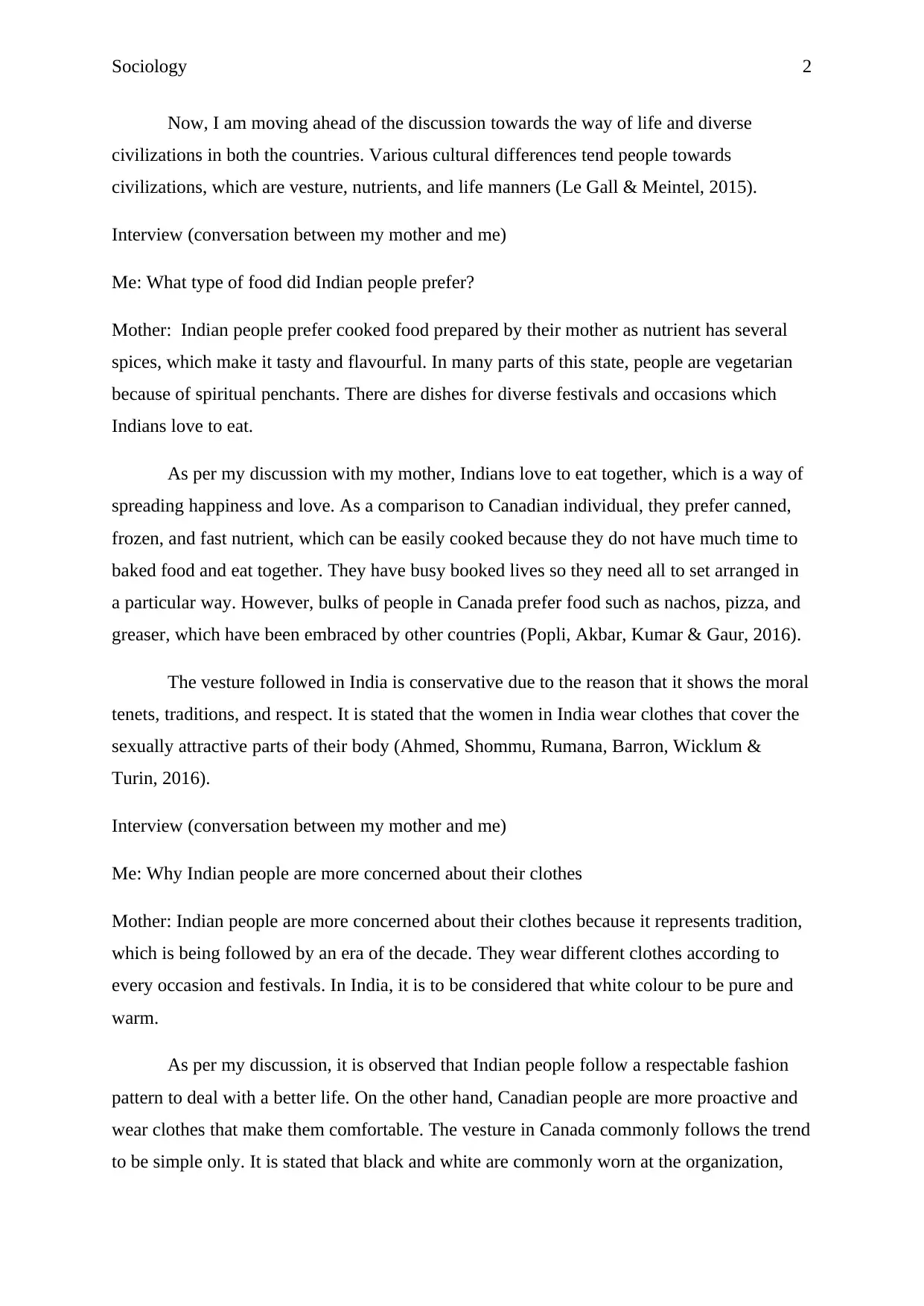
Sociology 2
Now, I am moving ahead of the discussion towards the way of life and diverse
civilizations in both the countries. Various cultural differences tend people towards
civilizations, which are vesture, nutrients, and life manners (Le Gall & Meintel, 2015).
Interview (conversation between my mother and me)
Me: What type of food did Indian people prefer?
Mother: Indian people prefer cooked food prepared by their mother as nutrient has several
spices, which make it tasty and flavourful. In many parts of this state, people are vegetarian
because of spiritual penchants. There are dishes for diverse festivals and occasions which
Indians love to eat.
As per my discussion with my mother, Indians love to eat together, which is a way of
spreading happiness and love. As a comparison to Canadian individual, they prefer canned,
frozen, and fast nutrient, which can be easily cooked because they do not have much time to
baked food and eat together. They have busy booked lives so they need all to set arranged in
a particular way. However, bulks of people in Canada prefer food such as nachos, pizza, and
greaser, which have been embraced by other countries (Popli, Akbar, Kumar & Gaur, 2016).
The vesture followed in India is conservative due to the reason that it shows the moral
tenets, traditions, and respect. It is stated that the women in India wear clothes that cover the
sexually attractive parts of their body (Ahmed, Shommu, Rumana, Barron, Wicklum &
Turin, 2016).
Interview (conversation between my mother and me)
Me: Why Indian people are more concerned about their clothes
Mother: Indian people are more concerned about their clothes because it represents tradition,
which is being followed by an era of the decade. They wear different clothes according to
every occasion and festivals. In India, it is to be considered that white colour to be pure and
warm.
As per my discussion, it is observed that Indian people follow a respectable fashion
pattern to deal with a better life. On the other hand, Canadian people are more proactive and
wear clothes that make them comfortable. The vesture in Canada commonly follows the trend
to be simple only. It is stated that black and white are commonly worn at the organization,
Now, I am moving ahead of the discussion towards the way of life and diverse
civilizations in both the countries. Various cultural differences tend people towards
civilizations, which are vesture, nutrients, and life manners (Le Gall & Meintel, 2015).
Interview (conversation between my mother and me)
Me: What type of food did Indian people prefer?
Mother: Indian people prefer cooked food prepared by their mother as nutrient has several
spices, which make it tasty and flavourful. In many parts of this state, people are vegetarian
because of spiritual penchants. There are dishes for diverse festivals and occasions which
Indians love to eat.
As per my discussion with my mother, Indians love to eat together, which is a way of
spreading happiness and love. As a comparison to Canadian individual, they prefer canned,
frozen, and fast nutrient, which can be easily cooked because they do not have much time to
baked food and eat together. They have busy booked lives so they need all to set arranged in
a particular way. However, bulks of people in Canada prefer food such as nachos, pizza, and
greaser, which have been embraced by other countries (Popli, Akbar, Kumar & Gaur, 2016).
The vesture followed in India is conservative due to the reason that it shows the moral
tenets, traditions, and respect. It is stated that the women in India wear clothes that cover the
sexually attractive parts of their body (Ahmed, Shommu, Rumana, Barron, Wicklum &
Turin, 2016).
Interview (conversation between my mother and me)
Me: Why Indian people are more concerned about their clothes
Mother: Indian people are more concerned about their clothes because it represents tradition,
which is being followed by an era of the decade. They wear different clothes according to
every occasion and festivals. In India, it is to be considered that white colour to be pure and
warm.
As per my discussion, it is observed that Indian people follow a respectable fashion
pattern to deal with a better life. On the other hand, Canadian people are more proactive and
wear clothes that make them comfortable. The vesture in Canada commonly follows the trend
to be simple only. It is stated that black and white are commonly worn at the organization,
⊘ This is a preview!⊘
Do you want full access?
Subscribe today to unlock all pages.

Trusted by 1+ million students worldwide
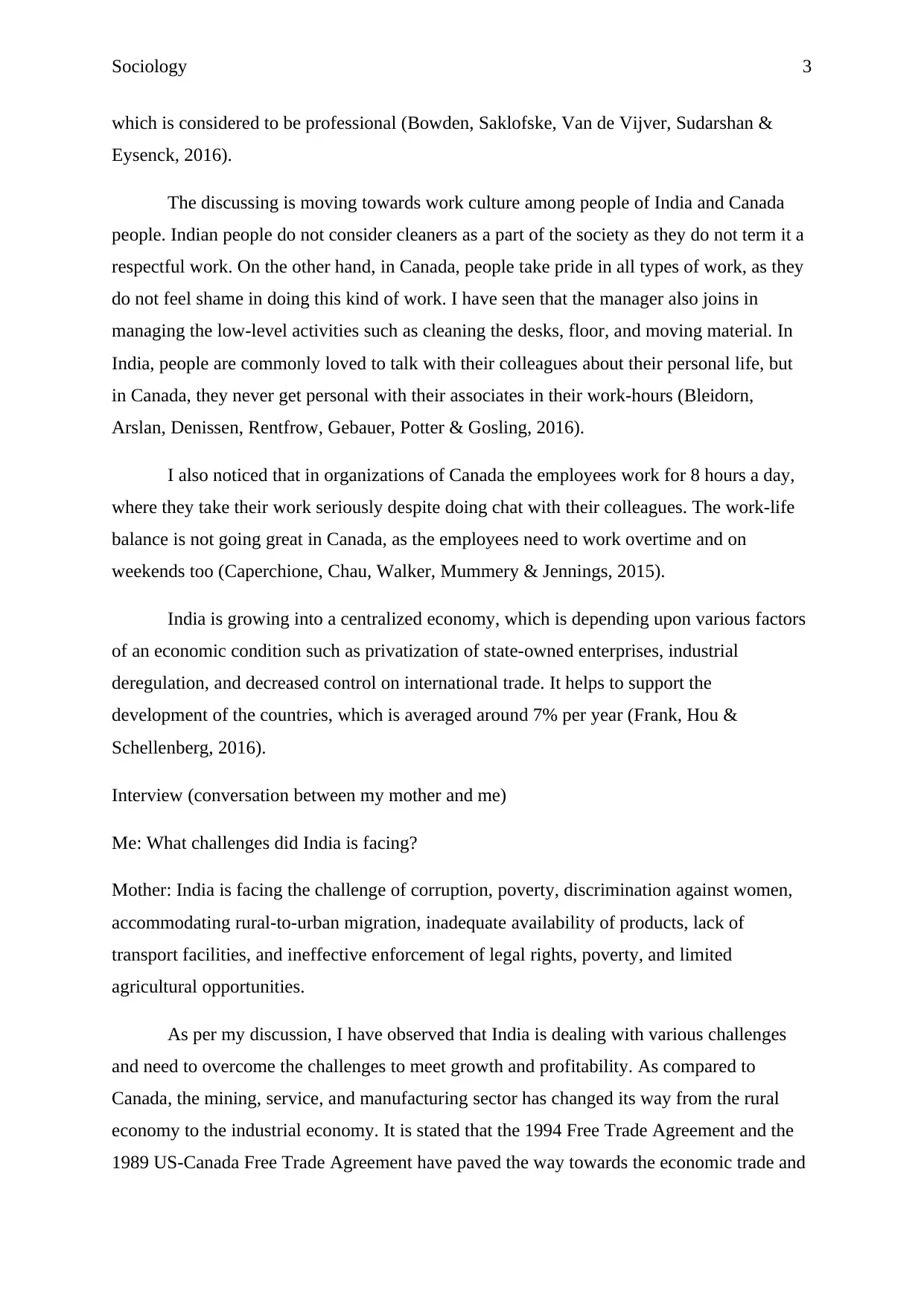
Sociology 3
which is considered to be professional (Bowden, Saklofske, Van de Vijver, Sudarshan &
Eysenck, 2016).
The discussing is moving towards work culture among people of India and Canada
people. Indian people do not consider cleaners as a part of the society as they do not term it a
respectful work. On the other hand, in Canada, people take pride in all types of work, as they
do not feel shame in doing this kind of work. I have seen that the manager also joins in
managing the low-level activities such as cleaning the desks, floor, and moving material. In
India, people are commonly loved to talk with their colleagues about their personal life, but
in Canada, they never get personal with their associates in their work-hours (Bleidorn,
Arslan, Denissen, Rentfrow, Gebauer, Potter & Gosling, 2016).
I also noticed that in organizations of Canada the employees work for 8 hours a day,
where they take their work seriously despite doing chat with their colleagues. The work-life
balance is not going great in Canada, as the employees need to work overtime and on
weekends too (Caperchione, Chau, Walker, Mummery & Jennings, 2015).
India is growing into a centralized economy, which is depending upon various factors
of an economic condition such as privatization of state-owned enterprises, industrial
deregulation, and decreased control on international trade. It helps to support the
development of the countries, which is averaged around 7% per year (Frank, Hou &
Schellenberg, 2016).
Interview (conversation between my mother and me)
Me: What challenges did India is facing?
Mother: India is facing the challenge of corruption, poverty, discrimination against women,
accommodating rural-to-urban migration, inadequate availability of products, lack of
transport facilities, and ineffective enforcement of legal rights, poverty, and limited
agricultural opportunities.
As per my discussion, I have observed that India is dealing with various challenges
and need to overcome the challenges to meet growth and profitability. As compared to
Canada, the mining, service, and manufacturing sector has changed its way from the rural
economy to the industrial economy. It is stated that the 1994 Free Trade Agreement and the
1989 US-Canada Free Trade Agreement have paved the way towards the economic trade and
which is considered to be professional (Bowden, Saklofske, Van de Vijver, Sudarshan &
Eysenck, 2016).
The discussing is moving towards work culture among people of India and Canada
people. Indian people do not consider cleaners as a part of the society as they do not term it a
respectful work. On the other hand, in Canada, people take pride in all types of work, as they
do not feel shame in doing this kind of work. I have seen that the manager also joins in
managing the low-level activities such as cleaning the desks, floor, and moving material. In
India, people are commonly loved to talk with their colleagues about their personal life, but
in Canada, they never get personal with their associates in their work-hours (Bleidorn,
Arslan, Denissen, Rentfrow, Gebauer, Potter & Gosling, 2016).
I also noticed that in organizations of Canada the employees work for 8 hours a day,
where they take their work seriously despite doing chat with their colleagues. The work-life
balance is not going great in Canada, as the employees need to work overtime and on
weekends too (Caperchione, Chau, Walker, Mummery & Jennings, 2015).
India is growing into a centralized economy, which is depending upon various factors
of an economic condition such as privatization of state-owned enterprises, industrial
deregulation, and decreased control on international trade. It helps to support the
development of the countries, which is averaged around 7% per year (Frank, Hou &
Schellenberg, 2016).
Interview (conversation between my mother and me)
Me: What challenges did India is facing?
Mother: India is facing the challenge of corruption, poverty, discrimination against women,
accommodating rural-to-urban migration, inadequate availability of products, lack of
transport facilities, and ineffective enforcement of legal rights, poverty, and limited
agricultural opportunities.
As per my discussion, I have observed that India is dealing with various challenges
and need to overcome the challenges to meet growth and profitability. As compared to
Canada, the mining, service, and manufacturing sector has changed its way from the rural
economy to the industrial economy. It is stated that the 1994 Free Trade Agreement and the
1989 US-Canada Free Trade Agreement have paved the way towards the economic trade and
Paraphrase This Document
Need a fresh take? Get an instant paraphrase of this document with our AI Paraphraser
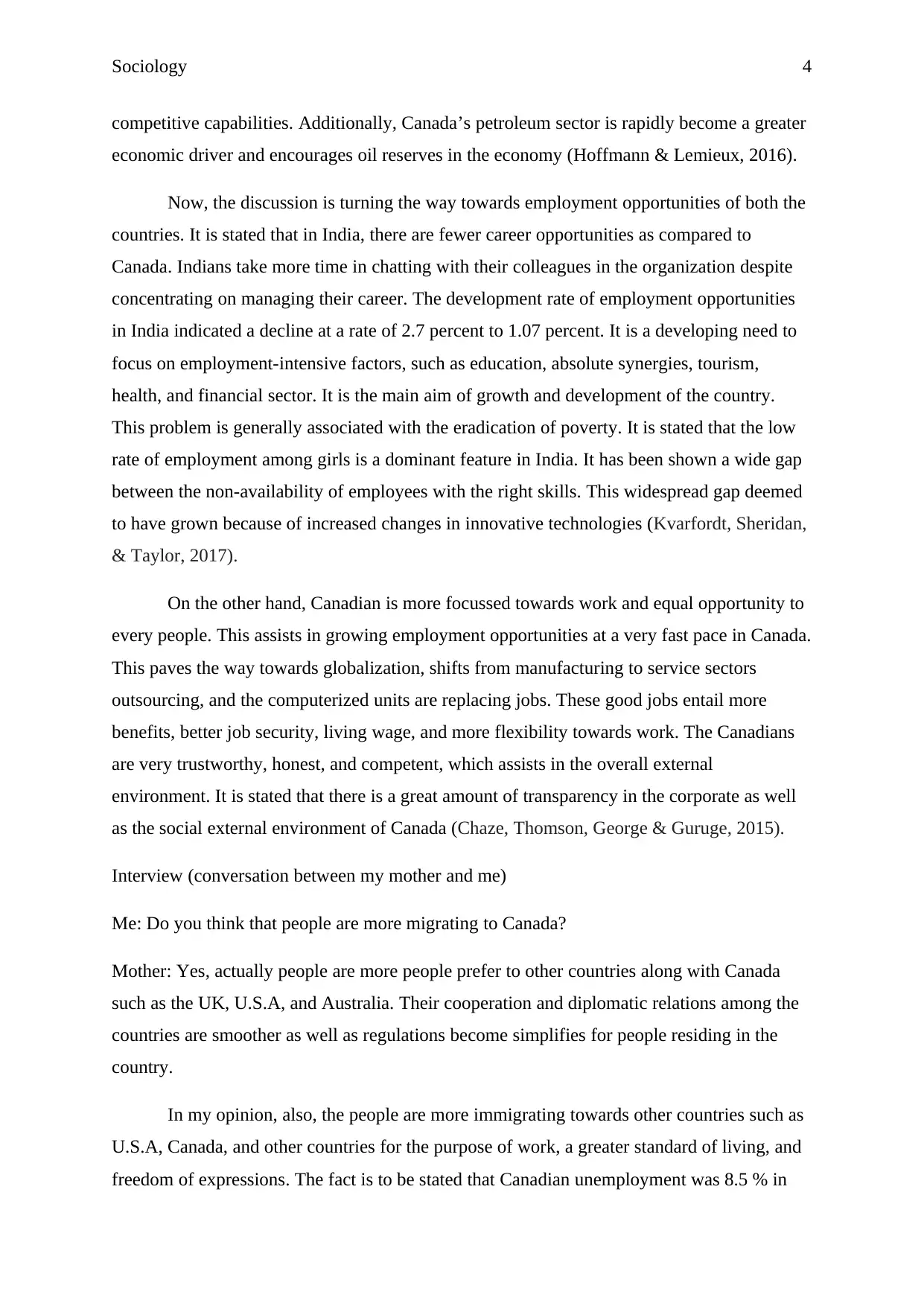
Sociology 4
competitive capabilities. Additionally, Canada’s petroleum sector is rapidly become a greater
economic driver and encourages oil reserves in the economy (Hoffmann & Lemieux, 2016).
Now, the discussion is turning the way towards employment opportunities of both the
countries. It is stated that in India, there are fewer career opportunities as compared to
Canada. Indians take more time in chatting with their colleagues in the organization despite
concentrating on managing their career. The development rate of employment opportunities
in India indicated a decline at a rate of 2.7 percent to 1.07 percent. It is a developing need to
focus on employment-intensive factors, such as education, absolute synergies, tourism,
health, and financial sector. It is the main aim of growth and development of the country.
This problem is generally associated with the eradication of poverty. It is stated that the low
rate of employment among girls is a dominant feature in India. It has been shown a wide gap
between the non-availability of employees with the right skills. This widespread gap deemed
to have grown because of increased changes in innovative technologies (Kvarfordt, Sheridan,
& Taylor, 2017).
On the other hand, Canadian is more focussed towards work and equal opportunity to
every people. This assists in growing employment opportunities at a very fast pace in Canada.
This paves the way towards globalization, shifts from manufacturing to service sectors
outsourcing, and the computerized units are replacing jobs. These good jobs entail more
benefits, better job security, living wage, and more flexibility towards work. The Canadians
are very trustworthy, honest, and competent, which assists in the overall external
environment. It is stated that there is a great amount of transparency in the corporate as well
as the social external environment of Canada (Chaze, Thomson, George & Guruge, 2015).
Interview (conversation between my mother and me)
Me: Do you think that people are more migrating to Canada?
Mother: Yes, actually people are more people prefer to other countries along with Canada
such as the UK, U.S.A, and Australia. Their cooperation and diplomatic relations among the
countries are smoother as well as regulations become simplifies for people residing in the
country.
In my opinion, also, the people are more immigrating towards other countries such as
U.S.A, Canada, and other countries for the purpose of work, a greater standard of living, and
freedom of expressions. The fact is to be stated that Canadian unemployment was 8.5 % in
competitive capabilities. Additionally, Canada’s petroleum sector is rapidly become a greater
economic driver and encourages oil reserves in the economy (Hoffmann & Lemieux, 2016).
Now, the discussion is turning the way towards employment opportunities of both the
countries. It is stated that in India, there are fewer career opportunities as compared to
Canada. Indians take more time in chatting with their colleagues in the organization despite
concentrating on managing their career. The development rate of employment opportunities
in India indicated a decline at a rate of 2.7 percent to 1.07 percent. It is a developing need to
focus on employment-intensive factors, such as education, absolute synergies, tourism,
health, and financial sector. It is the main aim of growth and development of the country.
This problem is generally associated with the eradication of poverty. It is stated that the low
rate of employment among girls is a dominant feature in India. It has been shown a wide gap
between the non-availability of employees with the right skills. This widespread gap deemed
to have grown because of increased changes in innovative technologies (Kvarfordt, Sheridan,
& Taylor, 2017).
On the other hand, Canadian is more focussed towards work and equal opportunity to
every people. This assists in growing employment opportunities at a very fast pace in Canada.
This paves the way towards globalization, shifts from manufacturing to service sectors
outsourcing, and the computerized units are replacing jobs. These good jobs entail more
benefits, better job security, living wage, and more flexibility towards work. The Canadians
are very trustworthy, honest, and competent, which assists in the overall external
environment. It is stated that there is a great amount of transparency in the corporate as well
as the social external environment of Canada (Chaze, Thomson, George & Guruge, 2015).
Interview (conversation between my mother and me)
Me: Do you think that people are more migrating to Canada?
Mother: Yes, actually people are more people prefer to other countries along with Canada
such as the UK, U.S.A, and Australia. Their cooperation and diplomatic relations among the
countries are smoother as well as regulations become simplifies for people residing in the
country.
In my opinion, also, the people are more immigrating towards other countries such as
U.S.A, Canada, and other countries for the purpose of work, a greater standard of living, and
freedom of expressions. The fact is to be stated that Canadian unemployment was 8.5 % in
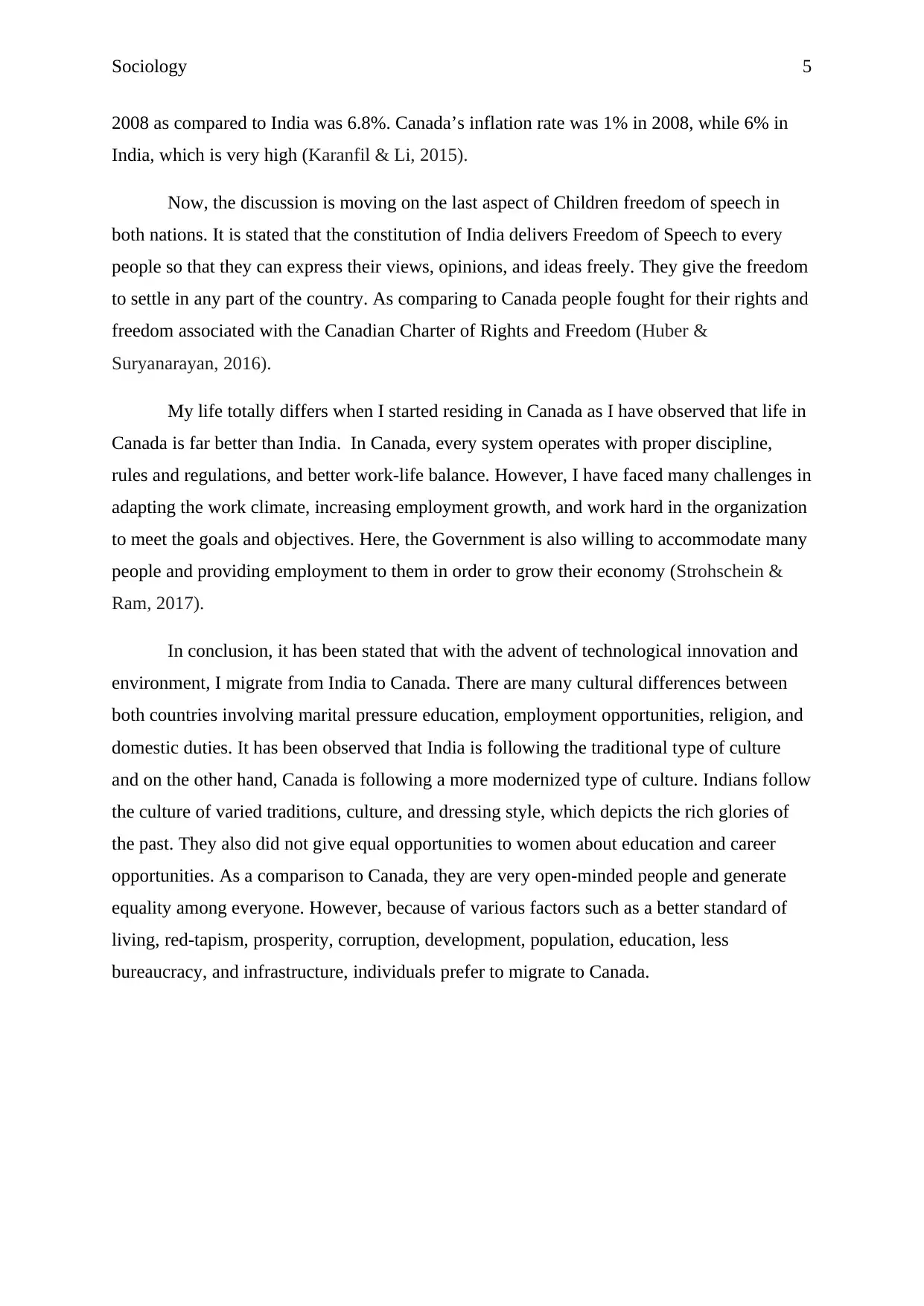
Sociology 5
2008 as compared to India was 6.8%. Canada’s inflation rate was 1% in 2008, while 6% in
India, which is very high (Karanfil & Li, 2015).
Now, the discussion is moving on the last aspect of Children freedom of speech in
both nations. It is stated that the constitution of India delivers Freedom of Speech to every
people so that they can express their views, opinions, and ideas freely. They give the freedom
to settle in any part of the country. As comparing to Canada people fought for their rights and
freedom associated with the Canadian Charter of Rights and Freedom (Huber &
Suryanarayan, 2016).
My life totally differs when I started residing in Canada as I have observed that life in
Canada is far better than India. In Canada, every system operates with proper discipline,
rules and regulations, and better work-life balance. However, I have faced many challenges in
adapting the work climate, increasing employment growth, and work hard in the organization
to meet the goals and objectives. Here, the Government is also willing to accommodate many
people and providing employment to them in order to grow their economy (Strohschein &
Ram, 2017).
In conclusion, it has been stated that with the advent of technological innovation and
environment, I migrate from India to Canada. There are many cultural differences between
both countries involving marital pressure education, employment opportunities, religion, and
domestic duties. It has been observed that India is following the traditional type of culture
and on the other hand, Canada is following a more modernized type of culture. Indians follow
the culture of varied traditions, culture, and dressing style, which depicts the rich glories of
the past. They also did not give equal opportunities to women about education and career
opportunities. As a comparison to Canada, they are very open-minded people and generate
equality among everyone. However, because of various factors such as a better standard of
living, red-tapism, prosperity, corruption, development, population, education, less
bureaucracy, and infrastructure, individuals prefer to migrate to Canada.
2008 as compared to India was 6.8%. Canada’s inflation rate was 1% in 2008, while 6% in
India, which is very high (Karanfil & Li, 2015).
Now, the discussion is moving on the last aspect of Children freedom of speech in
both nations. It is stated that the constitution of India delivers Freedom of Speech to every
people so that they can express their views, opinions, and ideas freely. They give the freedom
to settle in any part of the country. As comparing to Canada people fought for their rights and
freedom associated with the Canadian Charter of Rights and Freedom (Huber &
Suryanarayan, 2016).
My life totally differs when I started residing in Canada as I have observed that life in
Canada is far better than India. In Canada, every system operates with proper discipline,
rules and regulations, and better work-life balance. However, I have faced many challenges in
adapting the work climate, increasing employment growth, and work hard in the organization
to meet the goals and objectives. Here, the Government is also willing to accommodate many
people and providing employment to them in order to grow their economy (Strohschein &
Ram, 2017).
In conclusion, it has been stated that with the advent of technological innovation and
environment, I migrate from India to Canada. There are many cultural differences between
both countries involving marital pressure education, employment opportunities, religion, and
domestic duties. It has been observed that India is following the traditional type of culture
and on the other hand, Canada is following a more modernized type of culture. Indians follow
the culture of varied traditions, culture, and dressing style, which depicts the rich glories of
the past. They also did not give equal opportunities to women about education and career
opportunities. As a comparison to Canada, they are very open-minded people and generate
equality among everyone. However, because of various factors such as a better standard of
living, red-tapism, prosperity, corruption, development, population, education, less
bureaucracy, and infrastructure, individuals prefer to migrate to Canada.
⊘ This is a preview!⊘
Do you want full access?
Subscribe today to unlock all pages.

Trusted by 1+ million students worldwide
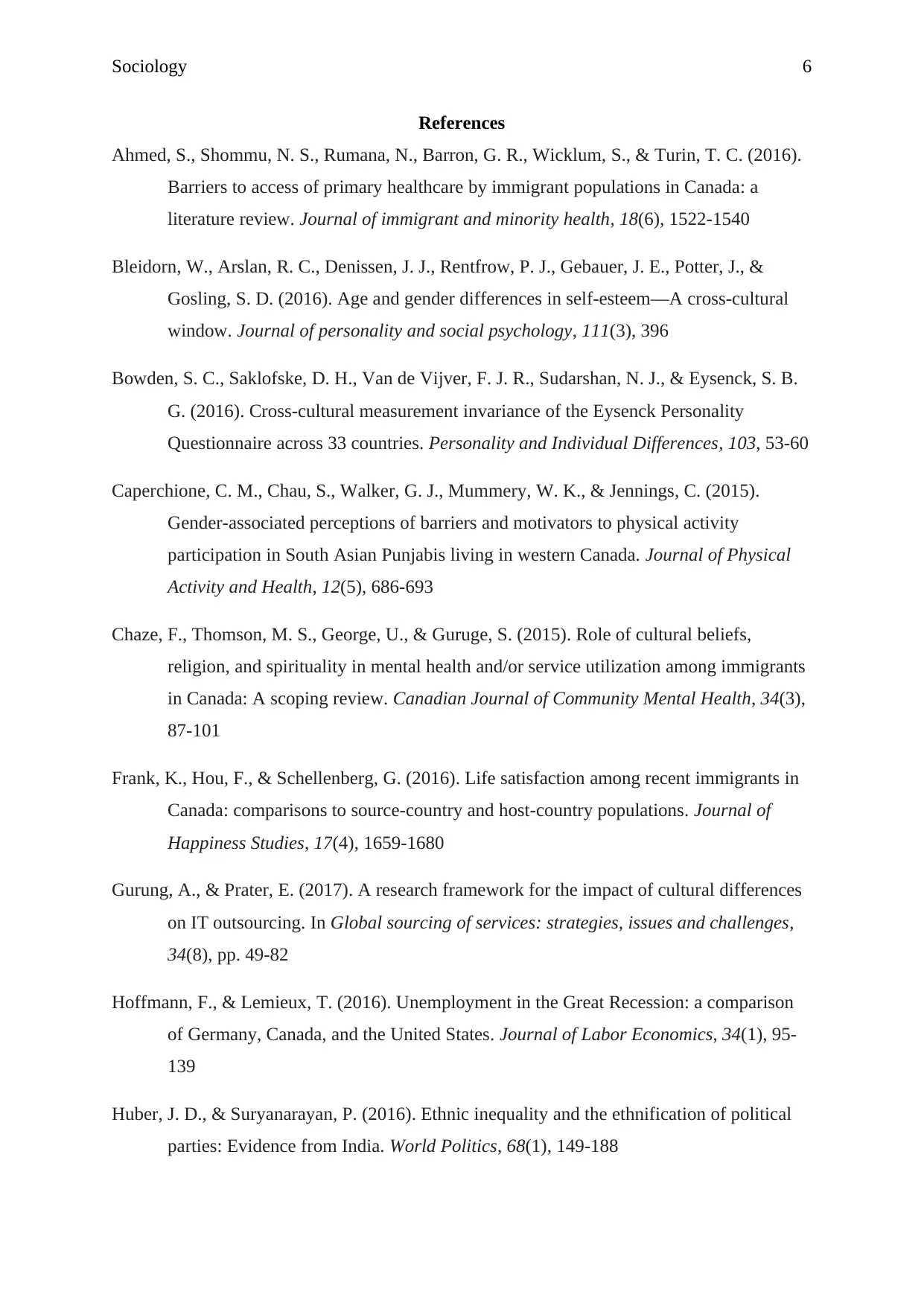
Sociology 6
References
Ahmed, S., Shommu, N. S., Rumana, N., Barron, G. R., Wicklum, S., & Turin, T. C. (2016).
Barriers to access of primary healthcare by immigrant populations in Canada: a
literature review. Journal of immigrant and minority health, 18(6), 1522-1540
Bleidorn, W., Arslan, R. C., Denissen, J. J., Rentfrow, P. J., Gebauer, J. E., Potter, J., &
Gosling, S. D. (2016). Age and gender differences in self-esteem—A cross-cultural
window. Journal of personality and social psychology, 111(3), 396
Bowden, S. C., Saklofske, D. H., Van de Vijver, F. J. R., Sudarshan, N. J., & Eysenck, S. B.
G. (2016). Cross-cultural measurement invariance of the Eysenck Personality
Questionnaire across 33 countries. Personality and Individual Differences, 103, 53-60
Caperchione, C. M., Chau, S., Walker, G. J., Mummery, W. K., & Jennings, C. (2015).
Gender-associated perceptions of barriers and motivators to physical activity
participation in South Asian Punjabis living in western Canada. Journal of Physical
Activity and Health, 12(5), 686-693
Chaze, F., Thomson, M. S., George, U., & Guruge, S. (2015). Role of cultural beliefs,
religion, and spirituality in mental health and/or service utilization among immigrants
in Canada: A scoping review. Canadian Journal of Community Mental Health, 34(3),
87-101
Frank, K., Hou, F., & Schellenberg, G. (2016). Life satisfaction among recent immigrants in
Canada: comparisons to source-country and host-country populations. Journal of
Happiness Studies, 17(4), 1659-1680
Gurung, A., & Prater, E. (2017). A research framework for the impact of cultural differences
on IT outsourcing. In Global sourcing of services: strategies, issues and challenges,
34(8), pp. 49-82
Hoffmann, F., & Lemieux, T. (2016). Unemployment in the Great Recession: a comparison
of Germany, Canada, and the United States. Journal of Labor Economics, 34(1), 95-
139
Huber, J. D., & Suryanarayan, P. (2016). Ethnic inequality and the ethnification of political
parties: Evidence from India. World Politics, 68(1), 149-188
References
Ahmed, S., Shommu, N. S., Rumana, N., Barron, G. R., Wicklum, S., & Turin, T. C. (2016).
Barriers to access of primary healthcare by immigrant populations in Canada: a
literature review. Journal of immigrant and minority health, 18(6), 1522-1540
Bleidorn, W., Arslan, R. C., Denissen, J. J., Rentfrow, P. J., Gebauer, J. E., Potter, J., &
Gosling, S. D. (2016). Age and gender differences in self-esteem—A cross-cultural
window. Journal of personality and social psychology, 111(3), 396
Bowden, S. C., Saklofske, D. H., Van de Vijver, F. J. R., Sudarshan, N. J., & Eysenck, S. B.
G. (2016). Cross-cultural measurement invariance of the Eysenck Personality
Questionnaire across 33 countries. Personality and Individual Differences, 103, 53-60
Caperchione, C. M., Chau, S., Walker, G. J., Mummery, W. K., & Jennings, C. (2015).
Gender-associated perceptions of barriers and motivators to physical activity
participation in South Asian Punjabis living in western Canada. Journal of Physical
Activity and Health, 12(5), 686-693
Chaze, F., Thomson, M. S., George, U., & Guruge, S. (2015). Role of cultural beliefs,
religion, and spirituality in mental health and/or service utilization among immigrants
in Canada: A scoping review. Canadian Journal of Community Mental Health, 34(3),
87-101
Frank, K., Hou, F., & Schellenberg, G. (2016). Life satisfaction among recent immigrants in
Canada: comparisons to source-country and host-country populations. Journal of
Happiness Studies, 17(4), 1659-1680
Gurung, A., & Prater, E. (2017). A research framework for the impact of cultural differences
on IT outsourcing. In Global sourcing of services: strategies, issues and challenges,
34(8), pp. 49-82
Hoffmann, F., & Lemieux, T. (2016). Unemployment in the Great Recession: a comparison
of Germany, Canada, and the United States. Journal of Labor Economics, 34(1), 95-
139
Huber, J. D., & Suryanarayan, P. (2016). Ethnic inequality and the ethnification of political
parties: Evidence from India. World Politics, 68(1), 149-188
Paraphrase This Document
Need a fresh take? Get an instant paraphrase of this document with our AI Paraphraser
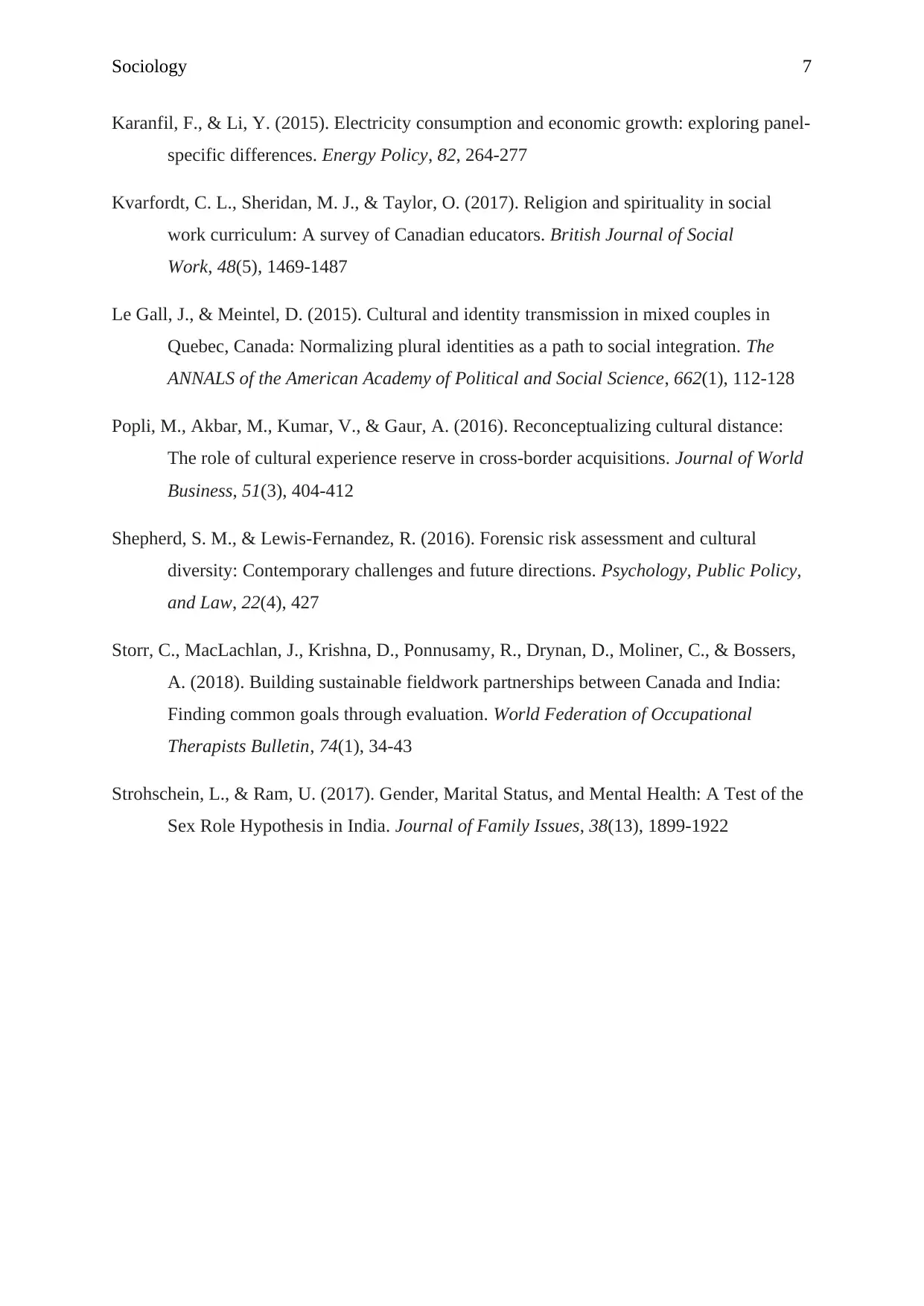
Sociology 7
Karanfil, F., & Li, Y. (2015). Electricity consumption and economic growth: exploring panel-
specific differences. Energy Policy, 82, 264-277
Kvarfordt, C. L., Sheridan, M. J., & Taylor, O. (2017). Religion and spirituality in social
work curriculum: A survey of Canadian educators. British Journal of Social
Work, 48(5), 1469-1487
Le Gall, J., & Meintel, D. (2015). Cultural and identity transmission in mixed couples in
Quebec, Canada: Normalizing plural identities as a path to social integration. The
ANNALS of the American Academy of Political and Social Science, 662(1), 112-128
Popli, M., Akbar, M., Kumar, V., & Gaur, A. (2016). Reconceptualizing cultural distance:
The role of cultural experience reserve in cross-border acquisitions. Journal of World
Business, 51(3), 404-412
Shepherd, S. M., & Lewis-Fernandez, R. (2016). Forensic risk assessment and cultural
diversity: Contemporary challenges and future directions. Psychology, Public Policy,
and Law, 22(4), 427
Storr, C., MacLachlan, J., Krishna, D., Ponnusamy, R., Drynan, D., Moliner, C., & Bossers,
A. (2018). Building sustainable fieldwork partnerships between Canada and India:
Finding common goals through evaluation. World Federation of Occupational
Therapists Bulletin, 74(1), 34-43
Strohschein, L., & Ram, U. (2017). Gender, Marital Status, and Mental Health: A Test of the
Sex Role Hypothesis in India. Journal of Family Issues, 38(13), 1899-1922
Karanfil, F., & Li, Y. (2015). Electricity consumption and economic growth: exploring panel-
specific differences. Energy Policy, 82, 264-277
Kvarfordt, C. L., Sheridan, M. J., & Taylor, O. (2017). Religion and spirituality in social
work curriculum: A survey of Canadian educators. British Journal of Social
Work, 48(5), 1469-1487
Le Gall, J., & Meintel, D. (2015). Cultural and identity transmission in mixed couples in
Quebec, Canada: Normalizing plural identities as a path to social integration. The
ANNALS of the American Academy of Political and Social Science, 662(1), 112-128
Popli, M., Akbar, M., Kumar, V., & Gaur, A. (2016). Reconceptualizing cultural distance:
The role of cultural experience reserve in cross-border acquisitions. Journal of World
Business, 51(3), 404-412
Shepherd, S. M., & Lewis-Fernandez, R. (2016). Forensic risk assessment and cultural
diversity: Contemporary challenges and future directions. Psychology, Public Policy,
and Law, 22(4), 427
Storr, C., MacLachlan, J., Krishna, D., Ponnusamy, R., Drynan, D., Moliner, C., & Bossers,
A. (2018). Building sustainable fieldwork partnerships between Canada and India:
Finding common goals through evaluation. World Federation of Occupational
Therapists Bulletin, 74(1), 34-43
Strohschein, L., & Ram, U. (2017). Gender, Marital Status, and Mental Health: A Test of the
Sex Role Hypothesis in India. Journal of Family Issues, 38(13), 1899-1922
1 out of 8
Related Documents
Your All-in-One AI-Powered Toolkit for Academic Success.
+13062052269
info@desklib.com
Available 24*7 on WhatsApp / Email
![[object Object]](/_next/static/media/star-bottom.7253800d.svg)
Unlock your academic potential
Copyright © 2020–2026 A2Z Services. All Rights Reserved. Developed and managed by ZUCOL.




